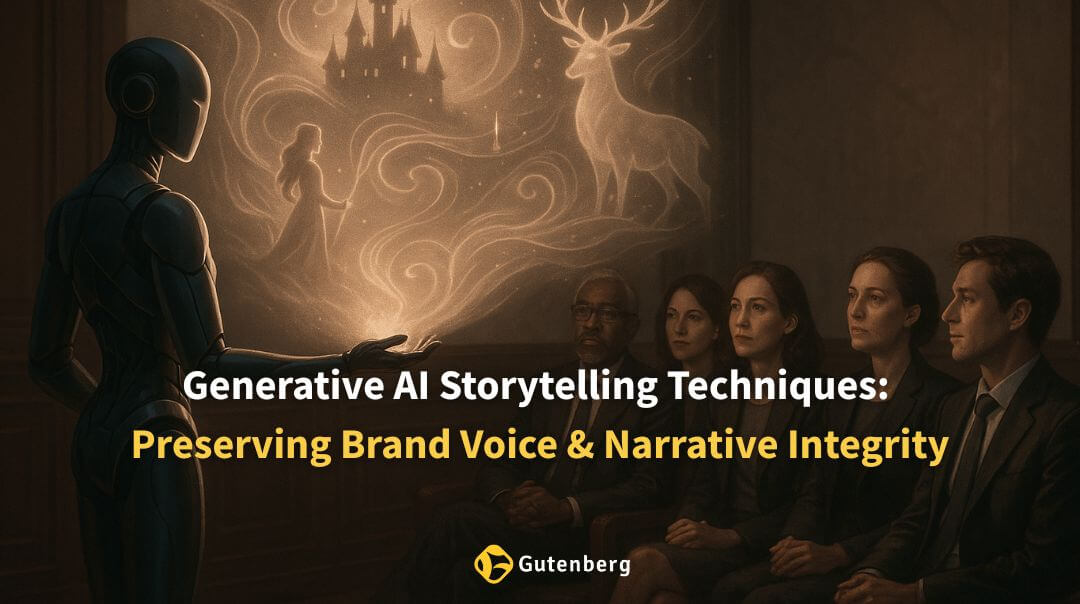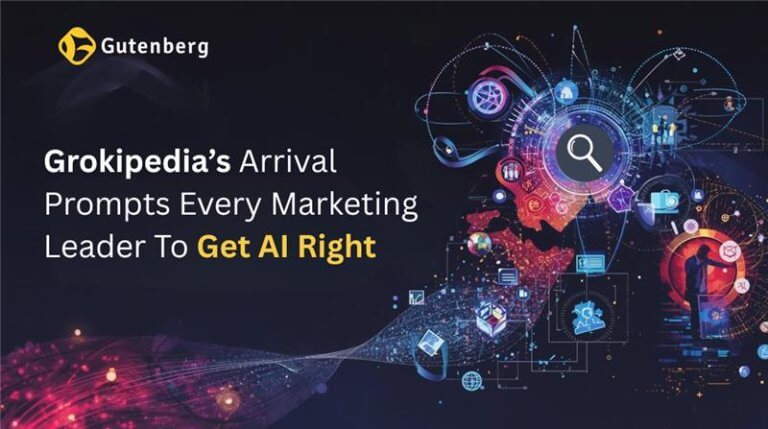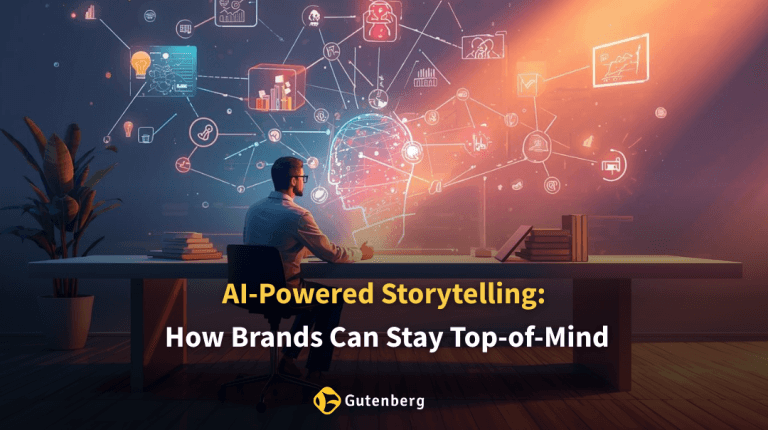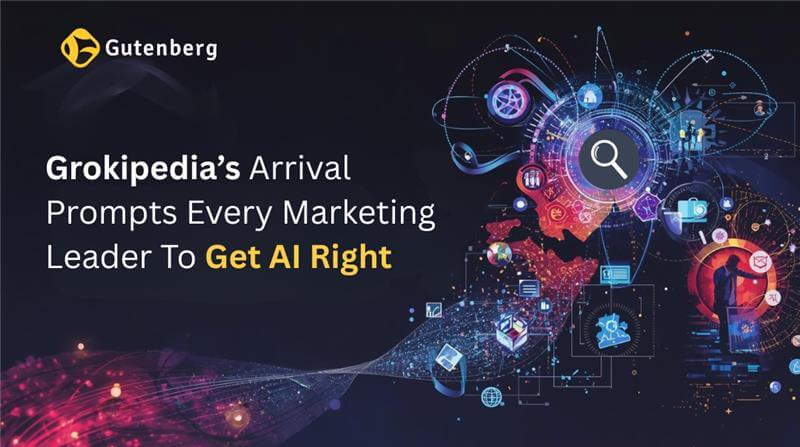51% of US marketers already use AI for storytelling—but how many preserve their brand’s human essence? As Generative AI storytelling techniques become standard, the challenge shifts: How do you scale personalization while keeping your brand’s human soul clear and intact? This blog explores how marketers can use Generative AI storytelling techniques to craft authentic experiences, preserve brand tone with AI, and safeguard narrative integrity. We’ll also spotlight best practices in AI content branding and answer the most-asked questions shaping this field right now.
Understanding Generative AI Storytelling Techniques
What are Generative AI Storytelling Techniques?
Generative AI storytelling techniques use machine learning to convert data and prompts into narrative-driven assets—text, images, videos, and even chatbots. These methods range from simple email personalization to full-funnel, omnichannel content campaigns tailored for different US audience segments.
Key Types:
- Data-driven narrative personalization
- Adaptive cross-platform storytelling
- Real-time story arc shaping for email, video, and social platforms
Generative AI storytelling techniques give brands the ability to engage huge audiences with hyper-relevant content, at a speed and scale that’s simply unattainable by human teams alone.
Why are Generative AI Storytelling Techniques Crucial for US Brands?
Applied strategically, Generative AI storytelling techniques allow brands to:
- Speak to American audiences in locally relevant dialects and styles
- Rapidly deploy campaign variations tuned to cultural context or region
- Maintain fresh, personalized engagement in real time
Today, 51% of US marketers are already using or testing AI for content, while 22% say adoption is imminent.
Brand Tone with AI: Authenticity at Scale
Staying relatable and recognizable is not just about what you say; it’s about brand tone with AI in every word, image, and story. With automation, the risk of tone drift increases. Consistent brand tone with AI requires more than uploading a style guide.
Training AI for Consistent Brand Voice
- AI draws from your brand values, historic campaigns, and approved templates.
- Platforms like Jasper and Adobe Firefly let brands ‘train’ models on style and language, supporting brand tone with AI.
The Role of Human Oversight in Brand Tone with AI
- Editorial review ensures AI output aligns with brand nuance.
- Feedback loops help refine tone and flag inaccuracies.
- C-suite leaders (83%) feel confident using generative AI, but only 29% of other employees do—a clear training gap
| Strength | How AI Helps | Watch-Outs |
|---|---|---|
| Consistency | Trained on historic assets, guidelines | Risk of generic voice |
| Real-time adjustment | Sentiment analysis & tuning | Cultural or regional misalignment |
| Efficiency | AI-generated draft saves time | “Uncanny” tone, requires review |
Risk Mitigation and Best Practices
- Avoid “uncanny” or off-brand messaging with layered oversight.
- Structure approval chains to catch errors and protect narrative clarity.
Narrative Integrity in Generative AI Storytelling
Many marketers worry: Can AI-generated content protect the soul of a story? Narrative integrity means every piece is accurate, logical, and brand-aligned from start to finish.
Safeguarding Narrative Integrity
- Use fact-checking, plagiarism detectors, and review panels
- Implement automated QA systems that spot “AI hallucinations”—claims not grounded in reality
Nearly 1 in 3 US marketers list accuracy and quality as their top AI challenge.
AI Content Branding and GEO for US Brands
In today’s search landscape, AI content branding is defined by more than keywords. Now, brands must adopt GEO—Generative Engine Optimization—to structure their stories for emerging AI engines and chatbots.
GEO and Local Optimization
- Use US-centric keyword trends, dialect, and regional references for better rankings.
- Apply structured data/schema so AI-driven engines can easily assemble your brand’s narrative in search and chat results.
| Best Practice | Description | AI Technique |
|---|---|---|
| Localized Keyword Optimization | Tailor content for US regions, slang, and queries | NLP, geo-data analysis |
| Structured Data & Schema | Help search engines “understand” your story | Auto-tagging, markup |
| Mobile/Voice Friendly | Adapt for American device habits | Voice NLP, responsive UX |
The Gutenberg Approach: AI Storytelling and Brand Voice Integrity
Integrated marketing leaders know that combining Generative AI storytelling techniques with human creativity produces the best results. At [placeholder: Gutenberg], brands receive AI-powered scalability, guided by strategy and hands-on review.
- Discover efficient, AI-driven asset creation for US campaigns.
- Maintain your unique brand tone with AI—every message, every story.
- Tap leaders in narrative design dedicated to preserving your narrative integrity.
Curious about AI-powered storytelling that keeps your brand’s human essence? Connect with Gutenberg to explore a tailored approach.
Key Trends in Generative AI Storytelling for US Brands
The US marketing landscape is shifting fast. Three trends stand out:
- AI-personalized content journeys for regional audiences are now the norm.
- Brands are blending avatars, video, and text—creating more engaging, relatable storytelling arcs.
- GEO replaces traditional SEO for visibility in chatbots and generative engines.
Actionable Takeaways: Building Narrative Integrity with Generative AI Storytelling Techniques
To fully harness Generative AI storytelling techniques without losing your essence:
- Integrate brand guidelines and values within your AI workflows.
- Prioritize human review for sensitive or public-facing content.
- Set up automated fact-checking and regular feedback cycles.
- Focus on GEO and US-local SEO improvements.
- Partner with proven experts like Gutenberg for a seamless, human-centered approach.
Frequently Asked Questions
1. What are Generative AI storytelling techniques?
They are methods that use machine learning to transform prompts and data into narrative-driven content such as blog posts, ads, videos, or chat interactions. These Generative AI storytelling techniques help brands scale personalized engagement without losing speed or reach.
2. How do brands keep their voice consistent when using AI?
Maintaining brand tone with AI requires training models on past campaigns, style guides, and approved language. Human oversight and editorial checks ensure AI-generated content stays authentic to the brand voice.
3. Can AI storytelling protect narrative integrity?
Yes, if brands combine automation with strong editorial workflows. Narrative integrity means stories remain fact-based, logical, and emotionally aligned with the brand. Gutenberg works with businesses to set up AI frameworks that keep every piece of content aligned with brand trust.
4. Why does brand tone with AI sometimes feel “off”?
If an AI system is trained on generic data, it may produce content that lacks emotional nuance or cultural fit. Embedding brand tone with AI guidelines and running regular reviews prevent tone drift.
5. What is AI content branding and why is it important?
AI content branding is the practice of shaping automated outputs so they reflect a brand’s values, visuals, and messaging across platforms. Gutenberg helps brands design AI content branding strategies that remain authentic across every customer touchpoint.
6. How do Generative AI storytelling techniques support US-focused campaigns?
They allow regional personalization, real-time message variation, and cultural adaptation. By applying Generative AI storytelling techniques, brands can speak to US audiences in ways that feel local, relevant, and authentic.
7. What risks should marketers watch out for with automated storytelling?
Common risks include factual errors, off-brand tone, and diluted storytelling. Protecting narrative integrity requires layered oversight and governance processes. With Gutenberg’s expertise, brands can minimize these risks and ensure AI content remains reliable.
















